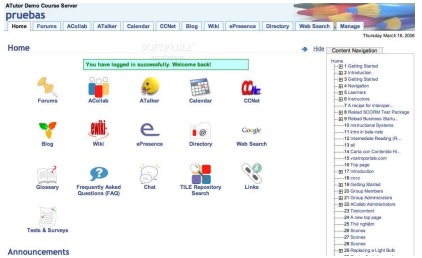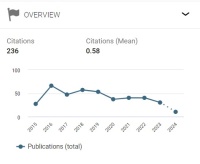Influencing Factors Dalam Menentukan Learning Management System Yang Sesuai Dalam Proses Transisi Ke Pembelajaran Daring
Abstract
In the current pandemic era, every learning process forced to do transition in a short notice, this action taken to prevent the widespread of COVID-19 virus in the school and university area. This hasty transition proceses are not companied by the readiness of Learning Management System platform that suitable for the education institution. This research is done by doing literature study and platform testing selected Learning Management Systems in order to fulfill its aim, to provide insight about Influencing Factors that can be used to segmenting Learning Management Systems Platform according to its suitability. This studi founds that there are 5 main factors and 3 supporting factors on deciding what Learning Management Systems Platform that will be use on any institution. The main factors consist of ease-of-use, course features, communication features, flexibility, and accessibility. The supporting factors consist of technician requirement, infrastructure requirement, and community support. From influencing factors, we also can devide Learning Management Platforms into 3 categories, there are free open-source, free cloud-based, and premium cloud-based.
Downloads
References
[2] “Daftar Wilayah di Indonesia yang Terapkan ‘Local Lockdown’ Halaman all - Kompas.com”.
[3] “Badan Pusat Statistik”.
[4] “Pembelajaran Online di Tengah Pandemi Covid-19, Tantangan yang Mendewasakan | Pusdatin”.
[5] J. J. Kim, Y. Yoon, E.-J. Kim, J. J. ; Kim, Y. ; Yoon, and E.-J. Kim, “A Comparison of Faculty and Student Acceptance Behavior toward Learning Management Systems,” Int. J. Environ. Res. Public Health 2021 Vol 18 Page 8570, vol. 18, no. 16, p. 8570, 2021, doi: 10.3390/IJERPH18168570.
[6] V. Singh and A. Thurman, “How Many Ways Can We Define Online Learning? A Systematic Literature Review of Definitions of Online Learning (1988-2018),” https://doi.org/10.1080/08923647.2019.1663082, vol. 33, no. 4, pp. 289–306, 2019, doi: 10.1080/08923647.2019.1663082.
[7] F. Mahnegar, “Learning Management System,” Int. J. Bus. Soc. Sci., vol. 3, no. 12, 2012.
[8] F. Khalid, N. N. M. Kasim, and F. Khalid, “Choosing the Right Learning Management System (LMS) for the Higher Education Institution Context: A Systematic Review,” Artic. Int. J. Emerg. Technol. Learn. IJET, 2016, doi: 10.3991/ijet.v11i06.5644.
[9] S. Iftakhar, “GOOGLE CLASSROOM: WHAT WORKS AND HOW?,” J. Educ. Soc. Sci., vol. 3.
[10] H. Dhika, F. Destiawati, M. Sonny, and M. Jaya, “Comparison of learning management system Moodle, Edmodo and Jejak Bali,” Adv. Soc. Sci. Educ. Humanit. Res., vol. 422, 2020.
[11] A. Alameen and B. Dhupia, “Implementing adaptive e-learning conceptual model: A survey and comparison with open source lms,” Int. J. Emerg. Technol. Learn., vol. 14, no. 21, pp. 18–45, 2019, doi: 10.3991/IJET.V14I21.11030.
[12] M. A. Almaiah, A. Al-Khasawneh, and A. Althunibat, “Exploring the critical challenges and factors influencing the E-learning system usage during COVID-19 pandemic,” Educ. Inf. Technol., vol. 25, no. 6, pp. 5261–5280, 2020, doi: 10.1007/S10639-020-10219-Y/FIGURES/3.
[13] A. Krouska, C. Troussas, and M. Virvou, “Comparing LMS and CMS platforms supporting social e-learning in higher education,” 2017 8th Int. Conf. Inf. Intell. Syst. Appl. IISA 2017, vol. 2018-January, pp. 1–6, 2018, doi: 10.1109/IISA.2017.8316408.
[14] M. Lynch, “E-Learning during a Global Pandemic.,” Asian J. Distance Educ., vol. 15, no. 1, pp. 189–195, 2020.
[15] R. Rabiman, M. Nurtanto, and N. Kholifah, “Design and Development E-Learning System by Learning Management System (LMS) in Vocational Education.,” Online Submiss., vol. 9, no. 1, pp. 1059–1063, 2020.
[16] K. Hadullo, K. Hadullo, R. Oboko, and E. Omwenga, “Factors affecting asynchronous e-learning quality in developing countries...,” Int. J. Educ. Dev. Using ICT, vol. 14, no. 1, 2018.
[17] P. Arnold, “Open educational resources or closed learning management systems?-The Challenge of Designing ICT Support for Learning Communities in Higher Education Open Educational Resources View project Study Success and Opportunities for Refugees in Higher Education-Analysis of Effectiveness (SUCCESS: Studienerfolg und-chancen für Geflüchtete-Wirksamkeitsanalysen) View project,” 2010, doi: 10.15353/joci.v6i3.2539.
[18] R. Kraleva, V. Kralev, M. Sabani, and S. #2, “An Analysis of Some Learning Management Systems”.
[19] B. Barman and J. Karthikeyan, “Facilitating ELT through Moodle and Google Classroom”.
[20] G. Gunawan, A. A. Purwoko, A. Ramdani, and M. Yustiqvar, “Pembelajaran Menggunakan Learning Management Systemberbasis Moodle pada Masa Pandemi Covid-19,” Indones. J. Teach. Educ., vol. 2, no. 1, Art. no. 1, Apr. 2021.
[21] T. Aikina and L. Bolsunovskaya, “Moodle-Based Learning: Motivating and Demotivating Factors,” Int. J. Emerg. Technol. Learn. IJET, vol. 15, no. 2, pp. 239–248, Jan. 2020.
[22] Linawati, I. N. D. Kotama, K. O. Saputra, I. M. S. Utama, N. D. Wirastuti, and T. Usagawa, “Proposed Plugin for Collaborative Game-Based Learning,” in 2019 IEEE International Conference on Engineering, Technology and Education (TALE), Dec. 2019, pp. 1–5. doi: 10.1109/TALE48000.2019.9225954.
[23] K. Heggart and J. Yoo, “Getting the most from Google Classroom : A pedagogical framework for tertiary educators.,” Aust. J. Teach. Educ., vol. 43, no. 3, pp. 140–153, doi: 10.3316/aeipt.220829.
[24] R. J. M. Ventayen, K. L. A. Estira, M. J. D. Guzman, C. M. Cabaluna, and N. N. Espinosa, “Usability Evaluation of Google Classroom: Basis for the Adaptation of GSuite E-Learning Platform,” Asia Pac. J. Educ., vol. 5, no. 1, p. 5, 2018.
[25] F. Ouatik and F. Ouatik, “Learning Management System Comparison: New Approach Using Multi-Criteria Decision Making,” Lect. Notes Bus. Inf. Process., vol. 416 LNBIP, pp. 239–248, May 2021, doi: 10.1007/978-3-030-76508-8_17.
[26] A. Bocevska, S. Savoska, B. Ristevski, N. Blazheska-Tabakovska, and I. Nedelkovski, “A Comparison of Accessible e-Learning Projects for Improving of Digital Health Literacy,” Sofia, Bulgaria, 2018, pp. 50–60. Accessed: Mar. 24, 2022. [Online]. Available: http://eprints.uklo.edu.mk/2331/
[27] M. Chengo, M. Hamamba, M. Mubanga, M. Nzila, and M. Simfukwe, “Investigating and Comparison of Affordances on Popular Open Source Learning Management Systems and Undergraduate Students’ Usability Evaluation of Moodle at The University of Zambia,” University of Zambia, Technical Report, Dec. 2021. Accessed: Mar. 24, 2022. [Online]. Available: http://lis.unza.zm:8080/archive/handle/123456789/118
[28] K. Khanchandani, S. Dhawan Chachra, and A. Naiksatam, “A Comparative Study on Interactive Digital Classrooms: Edmodo and Google,” in 2019 IEEE Tenth International Conference on Technology for Education (T4E), Dec. 2019, pp. 205–209. doi: 10.1109/T4E.2019.00046.
[29] D. Sulisworo, R. Ummah, M. Nursolikh, and W. Rahardjo, “The analysis of the critical thinking skills between blended learning implementation: Google Classroom and Schoology,” Univers. J. Educ. Res., vol. 8, no. 3, 2020.
[30] A. Alghafis, A. Alrasheed, and A. Abdulghany, A Study on the Usability of Moodle and Blackboard – Saudi Students Perspectives. International Association of Online Engineering, 2020, pp. 159–165. Accessed: Mar. 24, 2022. [Online]. Available: https://www.learntechlib.org/p/217784/
[31] F. Alturise, “Evaluation of Blackboard Learning Management System for Full Online Courses in Western Branch Colleges of Qassim University,” Int. J. Emerg. Technol. Learn. IJET, vol. 15, no. 15, pp. 33–51, Aug. 2020.


This work is licensed under a Creative Commons Attribution-NonCommercial-NoDerivatives 4.0 International License.

This work is licensed under a Creative Commons Attribution 4.0 International License




